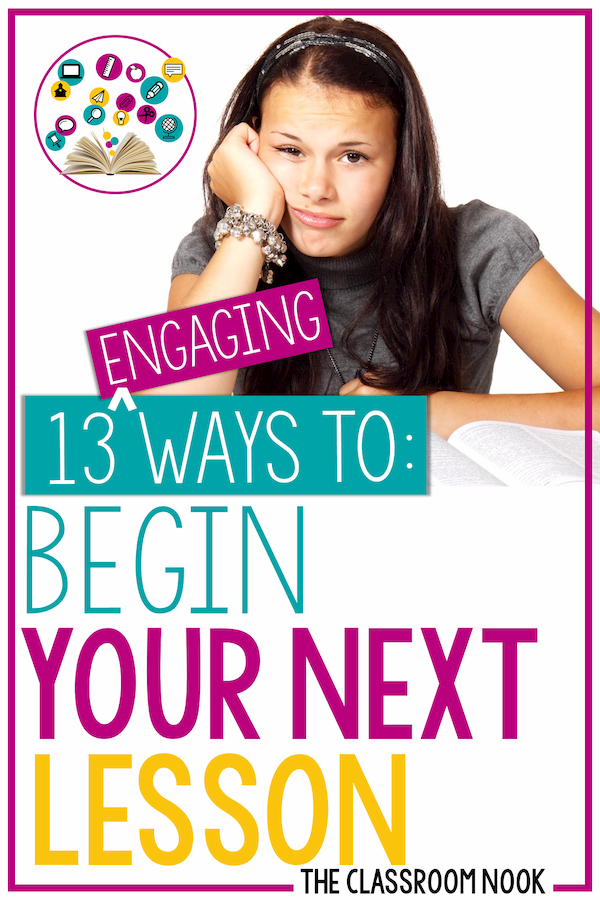Engaging Ways to Start Your Lesson
Love podcasts? Check out this post in the form of a podcast episode on The Classroom Commute Podcast:

We've all been there - staring out into a sea of glazed-over eyes as we begin a new lesson with our students. See that picture above? Look familiar? Are they even listening to you? OR have they begun to think about what they will eat for lunch?
Don't feel bad. It happens to every teacher.
It would be nice, however, if we had a few sure-fire ways to grab our students' attention (and keep it!). Well, I'm going to attempt to give you a quick list of unique ways to begin a lesson that DOESN'T start with "Today we're going to learn about..."
Ready? Here we go:
Mystery object/picture: Display an object or picture that represents your topic (without telling students what the topic is) and try to have your students guess the topic.
Listen to a song that sets the mood for your lesson:Think of the sounds of the marching drum and fifes when teaching the Civil War or the guitar and banjo sounds of the western expansion movement. Like the idea of using music in your classroom?
You May Also Like to Read: 9 USES FOR MUSIC IN THE ELEMENTARY CLASSROOM
Take a gallery walk: Place posters, pictures, artifacts, and other objects around your room that are related to your lesson. Students walk about the room and observe. You might even place large paper and markers at each gallery walk station around your room and have them create a "graffiti board" where they draw or write their thoughts about each station. This gallery walk sparks great discussion at the start of your lesson.
Read a poem related to your topic: (and sneak in a little fluency practice while your at it!)
Give your students a challenge: Before you TELL your students information about a topic, have them TRY it for themselves. Ideas include: solving a math riddle, giving students a list of content-related words and have them guess the topic, giving students several words related to your topic to sort into categories, give them an analogy, have them finish a sentence with their own thoughts, etc...
Play a game: A simple game like "stand up/sit down" requires no prep! Ask students a series of yes/no questions related to your topic and have them stand up (for yes) and sit down (for no) based on their answer. This makes a great review of the previous lesson or can help your quickly assess prior knowledge before introducing new content.
Start a debate: If your topic lends itself to having an opinion, pose a question and let students debate the topic. (Be sure to set some ground rules for disagreeing appropriately!)
Tell a story: Whether its a picture book, or just an oral story, grab students attention with a related story.
Reader's Theater: This is one of my favorite ways to teach new content. With a little prep ahead of time, you can easily create your own reader's theater to go along with your lesson. When I did this, I would take information from our text book and create a narrative out of it. For example, when teaching pollination during my plant unit, I created a reader's theater about 3 bee characters buzzing around the garden looking for nectar. Through their dialogue, the students learned about how bees carries pollen from one flower to the next. This also doubles as fluency practice!
Watch a video clip: YouTube is a teacher's best friend! With so many option, you can find a short video clip for just about anything! Think outside the box. For example, when I wanted to talk to my students about the Grand Canyon, I found a YouTube video of a helicopter ride someone posted of flying over the canyon.
Play "Gimme 5" (or 10, or 15)!: Give students your topic title (ex. animals, plant) and have them jot down the first 5, 10, 15... words or phrases that come to mind. You can even have them jot each thought down on post-it notes and create a chart.
Act it Out!: Place several different words or key phrases related to your topic on slips of paper. Have volunteer students act it out while their peers guess. Once you've gone through all of the slips of paper, review the words/phrases and use those words/phrases to introduce your topic.
Food: Is there some way to incorporate tasty treats into your lesson starter? Teaching arrays? Have students create them with M&Ms. Learning about a specific culture? Try some authentic food from that culture.
You May Also Like to Read: ENGAGING WAYS TO END YOUR LESSON
